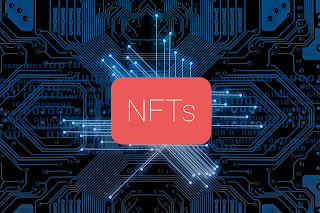NFT(non-fungible token) is a token that we can use to represent ownership of unique items. It lets us tokenize things like art, collectibles, even real estate. The first NFT project was in 2015 on the Ethereum blockchain.
What's an NFT?
You must have heard that Jack Dorsey, the Founder and CEO of Twitter, sold his very first tweet (which is also the very first tweet ever) for more than $2.9 million. A digital artwork piece by Mike Winkelmann aka Beeple sold for a whopping $69 million as an NFT. While all of this seems surprisingly great, we need to understand what exactly NFT is? But before that we must understand what fungibility and non fungibility means.
Non-fungible is an economic term that you could use to describe things like your furniture, a song file, or your computer. These things are not interchangeable for other items because they have unique properties. Fungible items, on the other hand, can be exchanged because their value defines them rather than their unique properties. A fungible asset is something with units that can be readily interchanged - like money.
A non-fungible token (NFT) is a unique and non-interchangeable unit of data stored on a digital ledger (blockchain). NFTs can be associated with easily-reproducible items such as photos, videos, audio, and other types of digital files as unique items (analogous to a certificate of authenticity), and use blockchain technology to give the NFT a verified and public proof of ownership. The lack of interchangeability (fungibility) distinguishes NFTs from blockchain cryptocurrencies, such as Bitcoin or Ether. So, an NFT is a digital asset that represents real-world objects like art, music, in-game items and videos. They are bought and sold online, frequently with cryptocurrency, and they are generally encoded with the same underlying software as many cryptos.
Why are they now becoming so popular?
Although they’ve been around since 2014-15, NFTs are gaining notoriety now because they are becoming an increasingly popular way to buy and sell digital artwork. A staggering $174 million has been spent on NFTs since November 2017. “Essentially, NFTs create digital scarcity,” says Arry Yu, chair of the Washington Technology Industry Association Cascadia Blockchain Council and managing director of Yellow Umbrella Ventures. This stands in stark contrast to most digital creations, which are almost always infinite in supply. Hypothetically, cutting off the supply should raise the value of a given asset, assuming it’s in demand. People are willing to spend millions on something they could easily replicate or copy because an NFT allows the buyer to own the original item. Not only that, it contains built-in authentication, which serves as proof of ownership. Collectors value those “digital bragging rights” almost more than the item itself.
How Is an NFT Different from Cryptocurrency?
NFT is generally built using the same kind of programming as cryptocurrency, like Bitcoin or Ethereum, but that’s where the similarity ends. Cryptocurrencies are “fungible,” meaning they can be traded or exchanged for one another. They’re also equal in value—one dollar is always worth another dollar; one Bitcoin is always equal to another Bitcoin. NFTs are different. Each has a digital signature that makes it impossible for NFTs to be exchanged for or equal to one another (hence, non-fungible).
How Does an NFT Work?
NFTs exist on a blockchain, which is a distributed public ledger that records transactions. Blockchain is the underlying process that makes NFTs and cryptocurrencies possible. Specifically, NFTs are typically held on the Ethereum blockchain, although other blockchains support them as well. An NFT is created, or “minted” from digital objects that represent both tangible and intangible items. Essentially, NFTs are like physical collector’s items, only digital. So instead of getting an actual oil painting to hang on the wall, the buyer gets a digital file instead.
They also get exclusive ownership rights. That’s right: NFTs can have only one owner at a time. NFTs’ unique data makes it easy to verify their ownership and transfer tokens between owners. The owner or creator can also store specific information inside them. For instance, artists can sign their artwork by including their signature in an NFT’s metadata.

